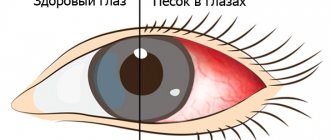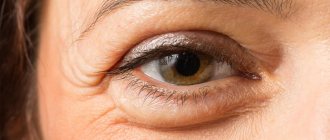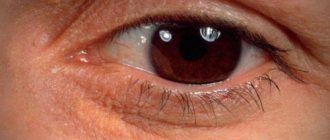Definition of disease
Diplopia is an anomaly that leads to visual impairment. Its essence is that the object that is in front of the eyes doubles. This occurs due to deviation of the visual axis of one organ of vision.
The development of an anomalous phenomenon occurs due to the fact that the image of the object in question, when the eyeball deviates, does not fall on the main fovea, but on another area of the retina.
When the image is doubled, binocular vision is always impaired.
This phenomenon disappears if a person closes one eye. Very rarely, monocular diplopia may occur. This pathological phenomenon implies that the same object produces two images in one eye. If you cover the second organ of vision, this phenomenon does not disappear.
Causes
When asking the question “why is there double vision?”, each patient will be able to receive an unambiguous answer from the doctor only from the point of view of the physiology of the process. During double vision, the human brain cannot coordinate the signals simultaneously coming from each eye, which indicates muscle disorders or harmful neurological processes.
Neurology associates diplopia with defects in the innervation of muscles by 3 cranial nerves:
- oculomotor;
- block;
- diverting.
The immediate causes of diplopia occur due to a number of factors:
- physiological conditioning: due to too close focusing or when perceiving an object closer than it actually is;
- intoxication of the body: the presence in it of high doses of drugs, sedatives, psychoactive substances (alcohol, opium);
- large-scale hemorrhages that interfere with normal eye movement;
- mild head injuries when diplopia is temporary;
- inflammatory processes of the orbit (orbit);
- eye refractive errors;
- injuries to the bones of the facial skull (fracture of the cheekbone, orbit, etc.).
During medical practice, many highly specialized specialists easily recall patients complaining of the symptom of “double vision.” In which disease this occurs most often, both an ophthalmologist, a neurologist, a rheumatologist, an oncologist, an endocrinologist, etc. can defend their point of view.
Diplopia is most often present when:
- stroke;
- cataracts;
- osteochondrosis of the neck area;
- diabetes mellitus or multiple sclerosis (mononeuropathy occurs - a functional disorder of a separate peripheral nerve);
- brain tumors;
- infectious diseases (rubella, diphtheria, botulism);
- for orbital myositis and many other diseases.
Causes
The development of the disease can be caused by incorrect placement of the eyeball in the orbit. This can be affected by various injuries - pinching of the muscles of the visual organ resulting from a fracture of the wall of the orbit. Incorrect position of the eyeball is another reason for the development of hematoma of the eye tissue.
Damage to the oculomotor nerve can also affect the pathological process. This can lead to:
- local dilatation of the carotid artery;
- tumors concentrated inside the skull;
- meningitis of tuberculous origin.
Various infectious processes formed against the background of the following pathologies can also affect diplopia:
- rubella;
- mumps;
- diphtheria;
- tetanus.
Read about laser surgery for glaucoma here.
Diplopia can be provoked by severe intoxication resulting from alcohol or medications.
Double image can be the result of such pathological conditions:
- botulism;
- thyrotoxicosis;
- multiple sclerosis;
- attacks of hysteria.
Diplopia can occur due to previous eye surgeries used in the treatment of strabismus, cataracts, glaucoma and retinal detachment.
Useful video
Diplopia is caused by various factors. To eliminate the disease, it is necessary to carry out diagnostic measures to determine the root causes. If there are any pathological conditions of the visual apparatus, they must be treated. Depending on the severity and level of the disease, special treatment methods are prescribed. To prevent the development of pathology, it is recommended to carry out prevention and adhere to a healthy lifestyle.
Author's rating
Author of the article
Alexandrova O.M.
Articles written
2031
about the author
Was the article helpful?
Rate the material on a five-point scale!
If you have any questions or want to share your opinion or experience, write a comment below.
Symptoms
Diplopia can be recognized by the following symptoms:
- double vision;
- difficulty determining the location of objects;
- regular dizziness.
The symptoms of the pathological process are determined taking into account the location of its location.
If the lesion was inflicted on the oblique muscles, then double vision involves depicting objects one after another. When the rectus muscles are damaged, parallel double vision occurs.
Two images of an object that are formed during pathology may differ in brightness and contrast. One of them can move vertically and horizontally, and be at a certain angle to the second object.
Often, to get rid of double vision, a person simply needs to turn or tilt his head in the direction of the lesion.
What it is?
Double vision, better known to doctors as double vision or diplopia , is a feature of the perception of the image of an object, which, falling on the same areas of both eyes, does not merge together and is seen as double.
Before considering the reasons for the development of diplopia, the symptoms and the possibility of treating this ophthalmological disorder, it should be noted that the mobility of the eyeball is directly affected - this creates conditions for the occurrence of several types :
- binocular: exists when the eyes are incorrectly displaced relative to each other (as a rule, the center of one eye is directed at a certain object, and the second - not at it, at another place);
- monocular: observed during perception with one eye, occurs much less frequently than binocular diplopia, has a different nature (damage to the cornea, structural defects of the eye, lens, pathology of the visual cortex);
- temporary: caused by special factors (spontaneously) - alcohol intoxication, fatigue of the muscles of the visual organ, traumatic brain injury, and should pass after a time interval; if normal visual perception is not restored, urgent consultation with an ophthalmologist is necessary.
Ophthalmologists also note a special type of diplopia - volitional . Its peculiarity: a person, with the help of volitional effort, is able to consciously split the perceived image - bringing his eyes together or spreading them in different directions. This can even be useful when perceiving visual stereo effects (stereograms). Video:
Possible complications
Diplopia refers to those pathologies that can occur without a general or specific clinical picture. If you start the disease and do not start treatment, the following complications arise :
- visual fatigue;
- Pain in the eyes;
- headache;
- blurred vision.
Read about aniseikonia in the article.
If these symptoms are detected, you should immediately visit a doctor, as this indicates the development of a more serious pathological process.
Treatment of diplopia
The main task of treating diplopia is to identify and immediately eliminate its causes. The form of emergency care is dictated by the course of the underlying disease. For example, for diphtheria, botulism, meningitis, immediate hospitalization to the infectious diseases department is indicated, for fractures in the skull to the neurosurgical or trauma department. In other cases of diplopia, hospitalization is carried out when the underlying disease is particularly severe or the general condition of the victim.
If diplopia is a consequence of only an ophthalmological disease, then treatment is usually carried out in the eye department of a hospital or in a specialized eye center.
Treatment
To get rid of the pathology, the patient must visit the doctor on time. Based on a diagnostic study, he will be able to establish a diagnosis and prescribe an effective treatment regimen.
Using glasses
The treatment of diplopia is based on prismatic correction. The essence of this technique is that the patient must wear special glasses. They allow you to optically eliminate the ghosting effect. The disadvantages of this method include a decrease in visual acuity while wearing glasses. So when prescribing them to children, additional attention should be paid to maintaining normal vision.
Read the material about why vision deteriorates.
Prismatic correction in the treatment of diplopia
Surgical method
To correct the pathology, surgery can be used. Surgical treatment is prescribed only after other methods of therapy have not given the desired result . For these purposes, two methods can be used:
- Recession of the eye muscle. During the operation, the eye muscle moves back, but the cut fascia is fixed to the sclera.
- Muscle resection. The purpose of this operation is to shorten the length of the muscle in order to compensate for the work of the affected one.
Read about presbyopia here.
Folk remedies
Folk remedies can be used to treat pathology. But this can be done provided that the reason for its development lies in the muscles, and not in the structure of the eyeball itself.
You should not self-medicate, as you need to know exactly what led to the split. Otherwise, there is a risk of complete loss of vision.
To alleviate the condition, the following methods can be used:
- Lavender tincture. Take 50 g of dry leaves, 30 g of valerian root and 1 liter of white wine. After mixing the components, they need to be left for 3 days. Then take the filtered drug in 20 ml doses.
- Buy pollen at the pharmacy. Take 10 ml 2 times a day. The duration of treatment will be 30 days.
- Take equal amounts of viburnum and rosehip berries. For 20 g of mixture there are 200 ml of water. Simmer for 10 minutes, cool and take 100 ml 2 times a day.
- Take 50 g of eyebright, add 2 cups of boiling water. Leave for 4-5 hours. Take the filtered infusion 10 ml 3 times a day.
- Take 30 g of blueberry leaves, add 200 ml of boiling water. Filter the infusion and take 10 ml 3 times a day.
- Take 20 g of calendula flowers, add 2 cups of hot water. Leave for 2 hours, filter and take throughout the day.
- You can simply add a few mint leaves to your tea.
Cure for stye on the eye you will find information at this link.
It is possible to treat diplopia with unconventional means, but the likelihood of successful treatment is low. They are best used in combination with other therapies.
Prevention
To prevent the development of diplopia, you should follow these simple recommendations:
- Treat inflammatory diseases of the nervous system in a timely manner.
- Prevent the development of vascular accidents. To do this, it is necessary to measure blood pressure levels and blood sugar concentrations.
- Monitor the level of thyroid hormones in the blood.
Causes of pupils of different sizes
Papilloma on the eyelid - this article will tell you how to treat these tumors.
Characteristics of children with visual impairment https://eyesdocs.ru/proverka-zreniya/uprazhneniya-dlya-glaz/xarakteristika-detej-s-narusheniem-zreniya.html
Causes of double vision
Speaking about the monocular form of the disease, it is worth considering the following reasons for its occurrence:
- Astigmatism, since with it only one eye has a split.
- Corneal dysfunction. Such as dryness, scarring and various infections.
- Also, against the background of clouding of the lens, a possible cause may be cataracts.
As for the binocular shape, the main reasons may be:
- Strabismus. It can be both a cause and a consequence of a disease.
- Various diseases characterized by impaired vascular function - cerebral aneurysm, stroke, hypertension.
- Diabetes. Due to damage to nerve endings.
- Autoimmune diseases such as myasthenia gravis and multiple sclerosis, which affect the central nervous system.
- Injuries. Traumatic brain injury is an extremely common cause of diplopia.
Considering a wider range of causes, diplopia can be caused by the following diseases:
- Neuropathy caused by B vitamin deficiency.
- Cervical osteochondrosis.
- Migraine, epilepsy, hypertensive crisis, stroke.
However, double vision has other causes. A correct clinical picture is possible only with timely diagnosis and detection of the localization site. For example, there is also a paralytic form of diplopia, it is characterized by paralysis of one or more eye muscles:
- When the rectus ocular muscles are damaged, the patient sees a parallel bifurcated image.
- With pathology in the oblique muscles, the image is located one above the other.
Often, the provocateurs of this visual disorder are also:
- Complications of various infectious diseases.
- Aneurysm of the carotid artery, leading to compression of the optic nerve.
- Thyroid dysfunction.
- Tumors inside the skull.
- Endocrine ophthalmopathy.
- Inflammation in the brain: meningitis, encephalitis.











